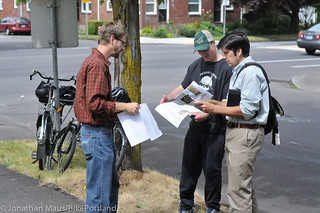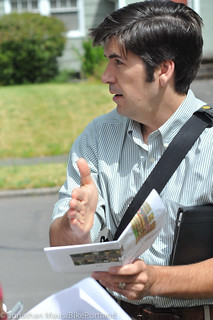
and Piedmont residents Justin Thompson (middle)
and Noah Brimhall discuss ideas to make Michigan Ave
work better.
(Photos © J. Maus/BikePortland)
Nearly two years ago, the Bureau of Transportation made a promise to residents of the Piedmont neighborhood: If a partial median at N. Rosa Parks Way and Michigan Avenue (map) doesn’t reduce cut-through traffic on the Michigan neighborhood greenway, they’ll beef it up. Yesterday, project manager Ross Swanson said he’d do just that.
Michigan is a unique case for PBOT. It’s the only major neighborhood greenway route in the city directly adjacent to an interstate highway. During the evening rush hour, “regional drivers” (which is, I think, PBOT’s politically correct way of saying Washington drivers) race up Michigan in an effort to bypass the daily gridlock on northbound I-5. The traffic and inconsiderate driving irks people who live on Michigan and the presence of so many cars flies in the face of the core mission of neighborhood greenways — to create conditions for low-stress bicycling.
When this project came up in the neighborhood back in July 2011, PBOT and some neighbors wanted to build a median that would prohibit people from turning left (west) off Michigan to access the I-5 on-ramp on Rosa Parks Way (see photo below). However, some residents felt that amount of diversion would be too much of an inconvenience to their driving habits. In the end, PBOT caved to those concerns; but promised to revisit the decision if the partial solution failed to solve the problem.

Yesterday, Swanson showed PBOT traffic data that proves — despite the speed bumps, 20 mph signage, and the presence of sharrows — that many people are still cutting through Michigan and other neighborhood streets to avoid I-5 (according to a PBOT license plate study that shows an increase in Washington plates at many locations). This means PBOT has failed to adequately discourage “regional drivers” from hopping off the freeway to save a few minutes on their commute.
Swanson acknowledged the problem yesterday during an on-site meeting organized by Piedmont resident Noah Brimhall. “Right now we’re not solving the cut-through problem,” Swanson said, “We want to make this neighborhood confusing to the regional driver.” He also shared that he gets frequent complaints of speeding from Michigan Avenue residents. “I’m ready to implement Phase 2. I feel like we have to live up to the commitment we made on Rosa Parks.”
While that’s good news for the neighborhood greenway, there’s still some work to be done. Brimhall, a nearby resident who has taken up the cause of making the Michigan greenway nicer for cycling, created a presentation for PBOT that outlines several proposals for how to divert traffic. Brimhall and other Piedmont neighbors concerned about the auto traffic on Michigan have continued to pressure PBOT to make further changes.
Yesterday, Swanson said he was prepared to make some immediate changes to the Rosa Parks/Michigan intersection. His plan was to immediately extend the existing median using plastic, “candlestick” bollards and paint as a temporary, low-cost measure. However, after analyzing the traffic data and hearing Brimhall’s ideas, Swanson says he’ll also consider other measures.


Brimhall says the goal is to make people in cars feel like guests when traveling on Michigan. He thinks (and Swanson agrees) the diversion should happen further south at Killingsworth, before people ever get to Rosa Parks Way. Brimhall’s proposal includes diverters at Killingsworth, Missouri, and Ainsworth. The idea is to push I-5 bound drivers east to N Albina, which is a larger, “neighborhood collector” street.
Swanson was very open to Brimhall’s ideas and plans to run them by PBOT staff and return to the neighborhood soon to begin implementing further changes. “I think there’s something here. The issue is, how do we not impact the adjacent neighbors.”
Stay tuned.
If you have feedback on this project, email Ross Swanson at ross.swanson@portlandoregon.gov.


